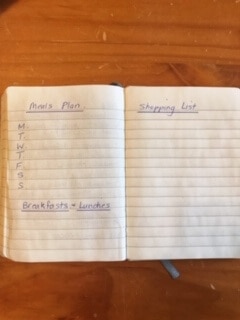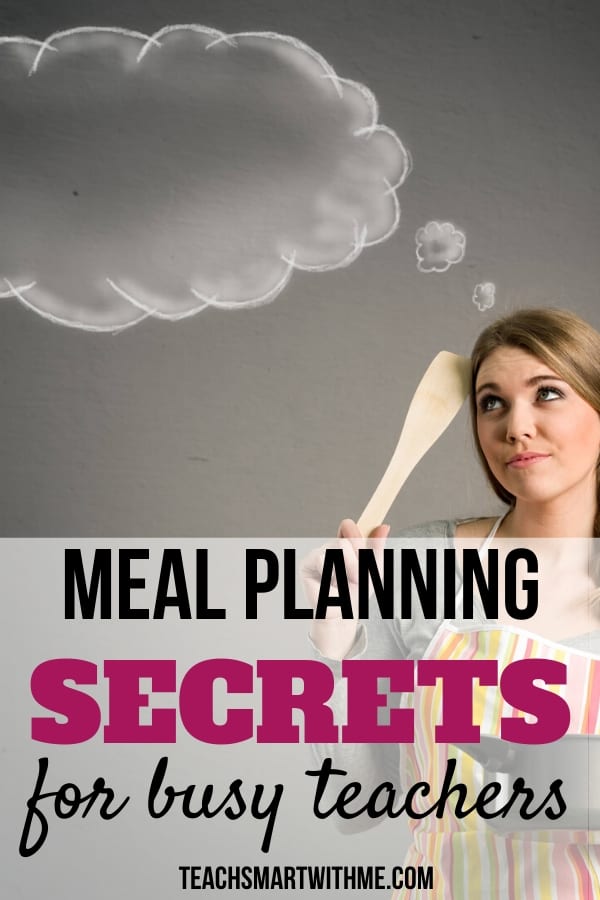Inside: A busy teacher reveals her secret to quick and easy meal planning for teachers to save heaps of time and stop the overwhelm when you get home after a tiring day at school.

I think one of the most important time-savers for busy teachers is to institute an easy meal planning strategy at home.
This sounds like a strange strategy to discuss for teachers to work smarter, but I know that when I get home from an exhausting day of teaching, the last thing I feel like doing is planning a meal and then have to cook it.
So I think having a streamlined strategy for meal-planning is one of the best ways to bet more organised as an overwhelmed and busy teacher.
This meal planning secret has been developed over time and it’s the most clever way to know the answer to the million-dollar question your family always bugs you about: “What’s for dinner?”
Instead of adding all those extra calories from your detour to McDonald’s, and feeling the guilt in the process – welcome to being in control and at ease when this question flies around after a tiring day at school.
No more feeling overwhelmed because you don’t know what to make for dinner. You’ll have it covered.
Get ready for the teachers’ meal plan that works!
What’s meal planning?
If you’re new to the concept of meal planning, because you don’t usually worry about thinking ahead and just buy dinner foods from day to day, or you really don’t cook much for one reason or the other, I’ll explain it for you.
Meal planning is a way you can think ahead for a week or more and consider what 7 evening meals and possibly lunches and breakfasts too that you’ll be eating for the whole week.
Many people that are familiar with meal planning use some sort of meal planning template on the fridge so they’re reminded of what they’re cooking for the week. Plus it’s then easy to delegate to your clueless partner and put them on dinner-duty without too much hassle.
What are the benefits of meal planning?
Meal planning is a much better way of providing dinners for your family. As it saves money, both because when you go to the supermarket with a list, you don’t buy foods that you won’t use, and it also stops the easy detour to the local drive-through on the way home.
The other benefit is that you’ll know what you’re going to cook that week and you’ll have all the ingredients waiting at home after you’ve done your regular shop.
Knowing this helps reduce some of the stress and overwhelm that food preparation can cause.
And I know I certainly don’t need any other stress added to my life – How about you?
How do you do meal planning?
I generally work on planning for main meals for my family as well as breakfast ideas, because I’m on my own health journey and don’t eat the usual breakfast foods; like toast and cereal.
You might like to plan for lunches too (I usually just have leftovers from the night before).
Related Article: Quick & Easy Snack Ideas for Teachers on the Run
Getting started with easy meal planning for busy teachers
Do this groundwork for your meal prep on the weekend or when you have a bit of brain space. It won’t take too long, but you will need to do a bit of thinking.
Step 1: Make a long list of all your favourite meals
The first thing to do is to write down all your families favourite foods or dishes that are always on the menu and they really love.
Just do a big brain dump of everything you can think of.
Here is an example of my families favourite meals, if you need some ideas:
- Shepherds Pie
- Steak and veggies
- Spaghetti Bolognaise
- Corn beef and roast vegies
- Bacon burgers or rissoles
- Stir-fries – both beef and chicken varieties
- Roast and veggies – beef, chicken and lamb
- Butter Chicken
- Lamb chops and Greek salad
- Nachos
- Turkey meatballs and noodles
- Marinated chicken bake and salad
O.K. so you get the picture.
If you’re stuck for ideas here’s a post for some quick, low-stress meals for teachers.
Remember when you do this, to write down as many meals as you can think of, including seasonal dishes, because the idea is, to come up with enough recipe ideas to plan for a month.
Woah!
I know I said I plan for a week, but a really clever meal planning hack is to do this for 4 weeks. It really doesn’t take much more time than doing it for 1 week.
This helps you to save so much more time by being able to rotate your list every month. You won’t have to think about what to cook and you also won’t get bored with your meal choices. It’s a WIN/WIN 🙂
Step 2: Arrange a variety of meals into weekly lists
The way I do this is I have one meal that we will eat every week.
This will depend on your families preferences.
At the moment in my family, we do steak every week. In some homes, they have a Mexican night; like Taco Tuesday or in your family you might like Spaghetti Bolognaise every week. (Whatever your staple meal is).
Now decide on this weekly dish. You will then arrange your meals around this one. Plus in our family, we generally do takeaway night once a week, especially when I’m working every day. (This is my reward for being a hard-working mum with a day job!)
Here is 4 weeks example that I’ve used previously. (It can be written on a scrap bit of paper because later you’ll write it into a notebook)
4 Weeks of Dinners for teachers:
| Meals List 1 | Meals List 2 | Meals List 3 | Meals List 4 |
| Butter Chicken | Shepherds Pie | Nachos | Rissoles & Veggies |
| Corned beef & veggies | Steak & Vegetables | Lamb chops & veggies | Lasagne & Salad |
| Meatloaf and vegetables | Beef & Bacon burgers | Beef Casserole | San Choy Bau |
| Spaghetti Bolognaise | Beef Massaman curry | Texan chicken & salad | Roast Chicken & Veggies |
| Thai Chicken Soup | Beef Stir Fry with Brocolli | Thai Chicken Curry | Steak & Salad |
| Steak and veggies | Roasted chicken legs | Steak & veggies | scrambled eggs |
| Take away | Take away | Takeaway | Takeaway |
You can see that we generally eat a meat and veggie/salad dish on most nights, but your list might look completely different to mine.
To make this list of meals more flexible and easy to work with, I don’t really designate a night that we will eat a certain meal – I find it’s too limiting.
So you should now have your list of 7 meals and then you can make whatever meal you feel like having on the night of your choosing because you should have purchased all the ingredient at the weekly grocery run.
Step 3. Plan your shopping list
I only write the one shopping list per week, as I find it quicker and easier this way and then you can add all the pantry items you need when you run out.
Bonus tip: From many years of using this meal planning secret, I found it beneficial to write the shopping list into a small hard-cover notebook – something smaller than B3 size. It’s more heavy-duty and lasts a lot longer, retaining all your recorded meal planning lists.
This little notebook fits easily into your handbag and it’s not cumbersome carrying around in the supermarket.
You also don’t have little scrap bits of paper everywhere.
Steps for writing your shopping list:
- Open your little notebook to a double page. On the left-hand side, write your seven meals in a list and add breakfast and lunch ideas here (S, M, T, W, T, F, S)
- On the right-hand side of the notebook, this is where you list out all of what you need to buy.

If you have recipes for your meals, you’ll need to have these in front of you to add the specialty ingredients to your list.
While you’re writing your list, check your pantry and fridge for what you have run out of and need to buy.
This is the more time-consuming part done.
Meal Planning Template
I don’t use a meal planning template anymore, but you can if you want. I just refer to the weekly meals plan in my notebook.
Sharing this plan with the family is also a clever idea too so that helpers can choose what they want to cook each night.
Over the next month, all you need to do now is write your new shopping list with the meals for that week in mind.
Over time, once you have gone through all four meal lists, you just repeat. Boom! So much time saved.
Final thoughts about meal planning for teachers
This meal planning secret of mine is pretty straightforward and simple to use.
I know that as a busy teacher, this system has been a life-saver for me and my family.
It’s one of the most effective time-saving ideas that I continue to use to be more organised at home, which cuts the overwhelm as a busy teacher.
It also helps me to provide healthy meals for my family as well as save money.
If you have any questions about this meal planning system, please feel free to email me or reply in the comments. I’m happy to clarify anything you need to know.
Happy cooking!
PIN IT FOR LATER!

Remember you’re worth it.
Michelle x
Other Articles you might like
Tips for Teachers: How to Stop Thinking About School


Leave a Reply